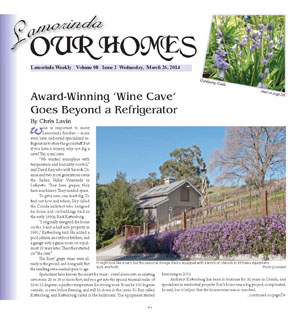| | Published March 26th, 2014
| Award-Winning 'Wine Cave' Goes Beyond a Refrigerator
| | By Chris Lavin | 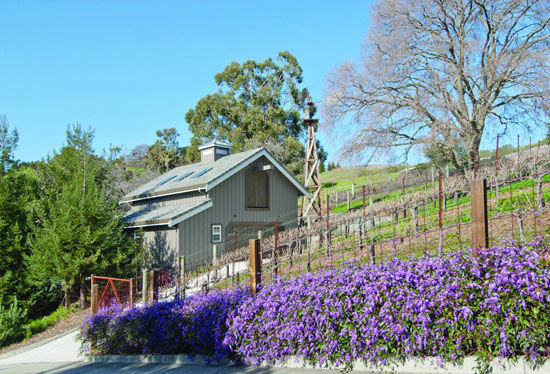 | | It might look like a barn, but this seasonal storage shed is equipped with a winch on steroids to lift heavy equipment back and forth. Photo provided |
Wine is important to many Lamorinda families - some even have dedicated specialized refrigerators to store the good stuff. But if you have a winery, why not dig a cave? Yes, a real cave.
 "We wanted someplace with temperature and humidity control," said David Rey, who with his wife Dianne and two more generations owns the Reliez Valley Vineyards in Lafayette. They have grapes, they have machinery. They needed space.
"We wanted someplace with temperature and humidity control," said David Rey, who with his wife Dianne and two more generations owns the Reliez Valley Vineyards in Lafayette. They have grapes, they have machinery. They needed space.
 To get a cave, one must dig. To find out how and where, Rey called the Orinda architect who designed his home and outbuildings back in the early 1990s, Rick Kattenburg.
To get a cave, one must dig. To find out how and where, Rey called the Orinda architect who designed his home and outbuildings back in the early 1990s, Rick Kattenburg.
 "I originally designed the home on the 2-and-a-half acre property in 1991," Kattenburg said. He added a pool cabana, an outdoor kitchen, and a garage with a game room on top almost 10 years later. Then they started on "the cave."
"I originally designed the home on the 2-and-a-half acre property in 1991," Kattenburg said. He added a pool cabana, an outdoor kitchen, and a garage with a game room on top almost 10 years later. Then they started on "the cave."
 The Reys' grape vines were already in the ground, and doing well. But the resulting wine needed space to age.
The Reys' grape vines were already in the ground, and doing well. But the resulting wine needed space to age.
 Spelunkers have known the secret for years - crawl down into an existing cave some 20 or 30 or more feet, and you get into the special thermal realm of 50 to 55 degrees , a perfect temperature for storing wine. It can be 100 degrees outside, or even below freezing, and still 55 down in the caves. So Rey called Kattenburg, and Kattenburg called in the bulldozers. The equipment started humming in 2012.
Spelunkers have known the secret for years - crawl down into an existing cave some 20 or 30 or more feet, and you get into the special thermal realm of 50 to 55 degrees , a perfect temperature for storing wine. It can be 100 degrees outside, or even below freezing, and still 55 down in the caves. So Rey called Kattenburg, and Kattenburg called in the bulldozers. The equipment started humming in 2012.
 Architect Kattenburg has been in business for 35 years in Orinda, and specializes in residential projects. Rey's home was a big project, complicated, he said, but it helped that the homeowner was so involved.
Architect Kattenburg has been in business for 35 years in Orinda, and specializes in residential projects. Rey's home was a big project, complicated, he said, but it helped that the homeowner was so involved.
 Kattenburg says he loves working with Rey, who was involved at every step of the project.
Kattenburg says he loves working with Rey, who was involved at every step of the project.
 They both watched as the 20-foot hole became a magnificent 1,000-square-foot barrel storage area, with a huge dining table in the center for entertaining, tasting and mixing. Now it's not only a center for tasting, but for socializing.
They both watched as the 20-foot hole became a magnificent 1,000-square-foot barrel storage area, with a huge dining table in the center for entertaining, tasting and mixing. Now it's not only a center for tasting, but for socializing.
 "It's incredible," Kattenburg says.
"It's incredible," Kattenburg says.
 But the road to fruition was long. The first step was, where to put a cave? Kattenburg gets out a piece of paper.
But the road to fruition was long. The first step was, where to put a cave? Kattenburg gets out a piece of paper.
 "We built the house originally with a fire truck turnout above the house," he said, his pencil outlining a driveway in his architect's hand. "We didn't want guests having to look down on cars." Face it, would you want to gaze out into the valley with a glass of wine in your hand, or onto a parking lot?
"We built the house originally with a fire truck turnout above the house," he said, his pencil outlining a driveway in his architect's hand. "We didn't want guests having to look down on cars." Face it, would you want to gaze out into the valley with a glass of wine in your hand, or onto a parking lot?
 They decided to dig the cave under the turnout - again thinking of unobstructed views, should equipment be in use. But at about 10 feet, the soil turned to rock. Heavier equipment like jackhammers were ordered. The hole got deeper.
They decided to dig the cave under the turnout - again thinking of unobstructed views, should equipment be in use. But at about 10 feet, the soil turned to rock. Heavier equipment like jackhammers were ordered. The hole got deeper.
 In the digging of the cave, Kattenburg and Rey discovered veins of shells that signified the edge of an ocean. Lamorinda Weekly covered that discovery of 6-million-year-old clam fossils (see story at https://www.lamorindaweekly.com/archive/
In the digging of the cave, Kattenburg and Rey discovered veins of shells that signified the edge of an ocean. Lamorinda Weekly covered that discovery of 6-million-year-old clam fossils (see story at https://www.lamorindaweekly.com/archive/
 issue0610/Beachfront-Vineyard-in-Lafayette-Cave-Dig-Unearths-6-10-Million-Year-Old-Fossils.html). The geology caused Kattenburg to modify the access to the cave, and a bent tunnel was built underground on a downward slope to tie in with the wine cave. Rey knew that the lime-rich history of the soil would be good for his grapes.
issue0610/Beachfront-Vineyard-in-Lafayette-Cave-Dig-Unearths-6-10-Million-Year-Old-Fossils.html). The geology caused Kattenburg to modify the access to the cave, and a bent tunnel was built underground on a downward slope to tie in with the wine cave. Rey knew that the lime-rich history of the soil would be good for his grapes.
 The project ended up, after completion, winning the 2014 Houzz Design Award, a coveted architectural prize awarded by the 16 million users of the Houzz site. "We are so honored," Kattenburg said. "It's a big deal."
The project ended up, after completion, winning the 2014 Houzz Design Award, a coveted architectural prize awarded by the 16 million users of the Houzz site. "We are so honored," Kattenburg said. "It's a big deal."
 Rey's relatively small 2-plus acres have cabernet sauvignon, zinfandel, syrah and other grapes lining the property. He also has a micro-brewery in the family, with the wine cave at its center. "It's a working wine cave," he said. "It's beautiful."
Rey's relatively small 2-plus acres have cabernet sauvignon, zinfandel, syrah and other grapes lining the property. He also has a micro-brewery in the family, with the wine cave at its center. "It's a working wine cave," he said. "It's beautiful."

|
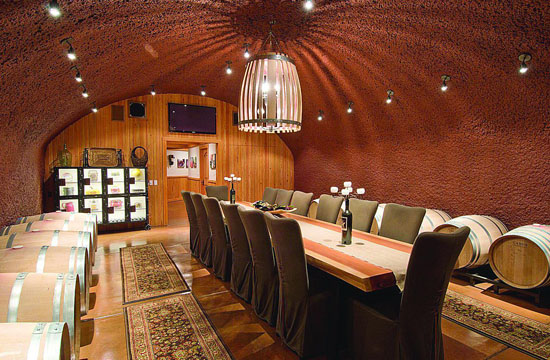 | | Owner David Rey and architect Rick Kattenburg decided on adding an entertainment area to the "wine cave," so tastings and dinners could be had right alongside barrels of aging wine. The chandelier in the center is made from a wine barrel. Photos courtesy Rick Kattenburg |  | | Reliez Valley Vineyards has more than one area for tasting and mixing, including this subterranean room that also serves as a tasting area for micro-brewed beer. | 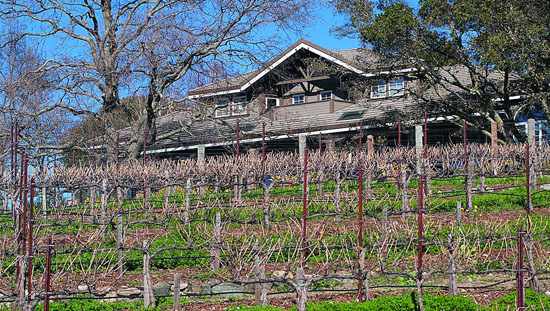 | | | 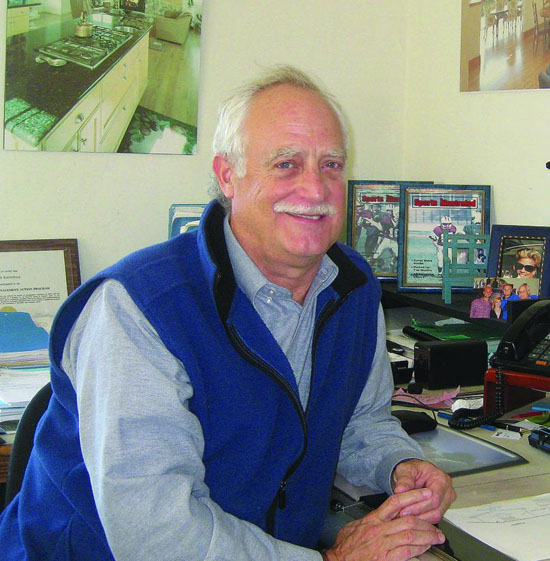 | | Architect Rick Kattenburg in his Orinda office. Photo Chris Lavin | | | |







